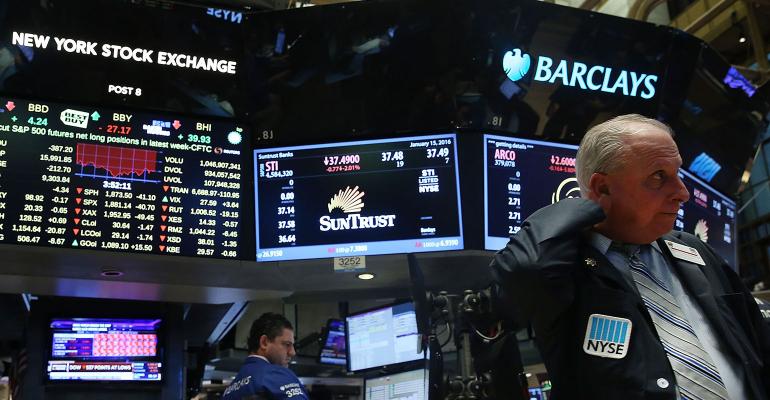(Bloomberg) -- Market watchers have heard the warnings over and over. Stocks are expensive. Growth is set to slow. Higher taxes and hawkish monetary policy loom as threats. Yet there’s a mighty force pushing back against all the bearish voices: buyers who keep on buying.
Demand is up across the board, from die-hard day traders piling into meme stocks, to exchange-traded funds and even once-cautious hedge funds now raising leverage to boost exposure. With dip buyers seemingly ready to jump in at every pullback, the S&P 500 Index has gone seven months without a 5% drawdown -- the longest stretch of buoyancy since February 2018.
Even a hawkish surprise from Federal Reserve policy makers -- they now expect to raise interest rates twice by the end of 2023, sooner than previously forecast -- didn’t seriously damage buyer sentiment on Wednesday, as the S&P 500 rebounded from a 1% drop to close down just 0.5%.
How long this robust demand can last is anyone’s guess. In the meantime, the hunger is driving up prices paid to those willing to part with equities at the moment, like pensions and mutual-fund investors.
All told, equity purchases by a group including households, hedge funds and ETFs exceeded sales by $361 billion in the first quarter, the most since at least the 1950s, Fed flow of funds data compiled by Reynolds Strategy LLC show. That extended five consecutive quarters of inflows, during which purchases topped $1 trillion, an amount that’s five times the total accumulated during the previous decade.
Corporate America, which had retrenched during the pandemic, is now also adding to demand, with share repurchases eclipsing offerings for a second quarter in a row.
Relentless stock buying has resulted in a market resilience that has defied all skeptics. Halfway into 2021, the S&P 500 has posted 29 fresh highs, on course for the third-best year for record closings, according to Bespoke Investment Group.
“Retail investors are right now the dominant factor in the rising stock prices, but if you are looking at how companies have been loading on debt and creating war chests for buybacks, should that retail demand falter, company buybacks are prepared to pick up the slack,” said Brian Reynolds, chief market strategist at his namesake firm. “That’s why this is a more durable bull market in addition to being a powerful one.”
In fact, the S&P 500 is up 90% from its March 2020 trough -- the best start of a bull market in nine decades. Technical speaking, it has yet to incur a 10% correction on a closing basis.
Along the way, warnings for a major market pullback are getting louder. In January, market veteran Byron Wien predicted the S&P 500 would tumble almost 20% in the first half before staging a rally. More recently, Morgan Stanley’s Mike Wilson and Ned Davis Research’s Ed Clissold have sounded alarms.
To some, the fanatic buying in and of itself is a sign of caution -- sentiment has become stretched, making the market vulnerable to negative shocks. At Bank of America Corp., the latest survey of money managers showed cash levels have fallen below the 4% threshold, triggering a sell signal.
Over at Citigroup Inc., chief U.S. equity strategist Tobias Levkovich counted four potential catalysts that could pose dangers for the market in the second half of the year -- the Fed’s discussion about rolling back its monetary stimulus, corporate tax hikes, inflation fears and the pressure on profit margins.
“We maintain a cautious view over the next several months,” Levkovich wrote in a note to clients, sticking to his year-end target of 4,000, which is 5% below the S&P 500’s last closing. “Sentiment remains ebullient, valuation is not attractive and the Street already expects strong profit trends.”
Read more:
Bubble Warnings Go Unheeded as Everyone Is a Buyer in Stocks
Zombies Defy Bankruptcy Logic Amid Meme-Driven Rally
S&P 500 Firms Beef Up Their Cash Piles to Deal With ‘New Normal’
Still, Levkovich advised investors to buy on dips partly because corporate repurchases are set to accelerate. Buttressed by a rebound in profits and near-record cash hoarding, announced buybacks have more than doubled this year to $570 billion, data compiled by Birinyi Associates show.
While retail interest in stocks, particularly meme names, will subside eventually, right now it’s too risky to go against the crowd, according to Michael Holland, chairman at Holland & Co.
“The reality is that all these things do go away, you just don’t know how long they take to go away,” Holland said in a Bloomberg Television interview. “I wouldn’t be real fast to get out of cash position and start shorting stocks.





